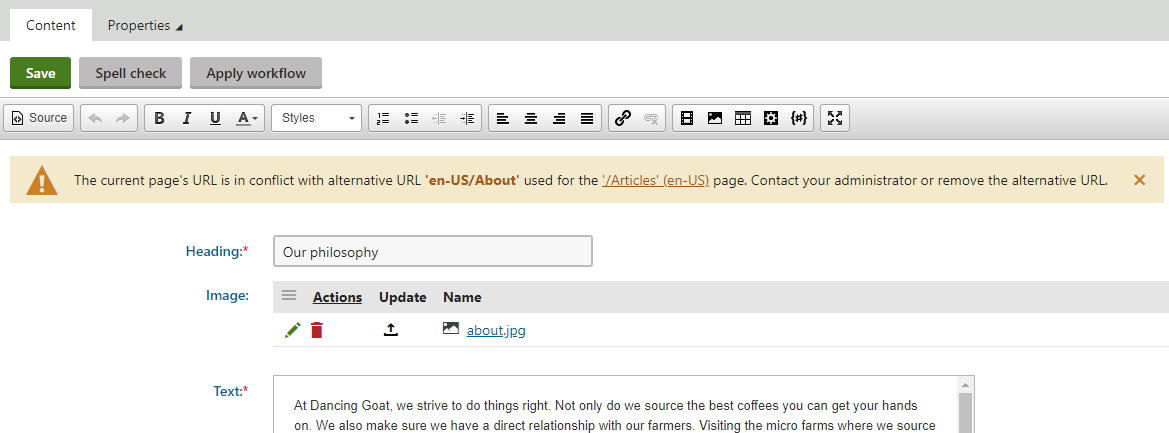Adding alternative URLs for pages
The URLs of pages are based on patterns predefined by the website’s developers or administrators. Content editors and marketers cannot directly edit the overall URLs. In some cases, you may have control over a part of the URL, for example if the URL pattern of a page type includes the page alias value.
If you need more flexibility when it comes to providing short and relevant-looking links to pages, you can leverage alternative URLs. This feature allows you to make individual pages available under any number of URLs, in addition to the main URL of the given page.
For example, in a scenario where an article page’s main URL is something like:
<site domain>/Articles/5d10aaaa-0d46-488e-a8db-5d6390386edb/New-products
you could add an alternative URL for the article page, and make it available under a shorter URL like:
<site domain>/NewProducts
When a visitor opens a page through an alternative URL, the system either redirects to the page’s main URL or displays the page content under the given alternative URL (depending on the site’s configuration).
Prerequisite
Before you can work with alternative URLs, your site’s developers need to enable and configure the feature. For detailed information, see Enabling alternative URLs for pages.
Editing alternative URLs
To add an alternative URL for a page:
- Open the Pages application.
- Select a page in the content tree.
- Your site’s content tree may contain pages for which you cannot add alternative URLs. This is the case for pages that do not represent actual pages on the website, and typically only store content displayed on other pages.
- On multilingual websites, make sure you have the correct culture selected. Each culture version of a page has its own alternative URLs. You cannot share an alternative URL between multiple culture versions of the same page.
- In Edit mode, switch to the Properties -> Alternative URLs tab.
- Type or copy the required URL into the New URL field.
- Only enter the path component of the URL. The scheme and authority URL components are fixed (i.e. the protocol, site domain and possibly a virtual directory).
- Query string parameters and fragment identifiers (i.e. values preceded by ‘?’ or ‘#’) are not supported in alternative URLs. Such values are automatically removed from the submitted URL.
- Click Add.

The page is now accessible through the added URL.
The interface displays a list of all alternative URLs defined for the page and allows you to edit () or delete () them.
URL conflicts and validation
When you add an alternative URL, the system automatically performs validation and checks for the following:
- Conflicts with the main URLs of existing pages on the site.
- Conflicts with other alternative URLs for any page on the same site.
- Restrictions and excluded URLs set up by the site’s developers or administrators.
The system prevents the creation of any alternative URLs that are not valid and displays an error message. In these cases, you need to try a different value, resolve the URL conflict, or contact an administrator.
URL conflicts can occur after creating a new page or editing an existing one, if the new main URL matches an existing alternative URL on the site. In these cases, the system does not stop the creation or update of the page. However, the Pages application displays a warning when viewing such pages and you can take steps to resolve the URL conflict.

To resolve URL conflicts, either change/delete the conflicting alternative URL, set a different value for a field that is part of the conflicting page’s main URL, or contact an administrator.
Moving pages with alternative URLs
To avoid potential URL conflicts, the system behaves in the following way when you copy or move pages that have alternative URLs:
- Moving pages to a different location within the same site preserves any alternative URLs.
- When moving pages to a different site:
- any alternative URLs that do not comply with the target site’s restrictions or excluded URLs are automatically deleted.
- the entire move operation is stopped if a conflict occurs with another alternative URL on the target site.
- Copying pages within the same site does NOT copy alternative URLs.
- When copying pages to a different site, the operation only includes alternative URLs that comply with the target site’s restrictions and are not in conflict with another alternative URL on the target site.